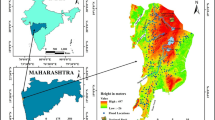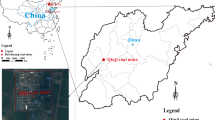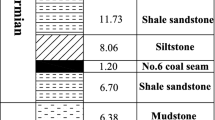Abstract
Disasters caused by water inrush affect many coal mines in China. In order to predict and prevent water inrushes during mining of the no. 17 coal seam in the Sanhejian coal mine, the factors that affect water inrush from the underlying Ordovician limestone were studied using the analytic hierarchy process (AHP). The AHP method is based on the geographic information system, through which the sub-thematic layer and the overlying layers of each dominating factor were constructed. An expert system was used to calculate weighting for each factor. Integration of the controlling factors through the AHP allowed us to develop a vulnerability index map in which the mining area was divided into different zones according to the risk level for water inrush during mining. Furthermore, water control measures were recommended in response to each risk level.
Kurzfassung
Zahlreiche Steinkohlengruben in China sind von Grubenunglücken infolge Wassereinbruch betroffen. Mit dem Ziel, Wassereinbrüche während des Abbaus des Flözes Nr. 17 in der Grube Sanhejian vorherzusagen und zu verhindern, wurden die für das Auftreten von Wassereinbrüchen aus dem liegenden ordovizischen Kalkstein maßgeblichen Faktoren mittels eines analytischen Hierarchieprozesses (AHP) untersucht. Die AHP Methode basiert auf der Anwendung eines Geographischen Informationssystems (GIS), mit dem thematische Karten aller dominierenden Faktoren konstruiert wurden. Mit Hilfe eines Expertensystems wurden Wichtungen für jeden Faktor ermittelt. Die mit Hilfe des AHP vorgenommene Zusammenführung der Einflussfaktoren erlaubte den Autoren die Erstellung einer Gefährdungsindexkarte, in der das Bergbaugebiet in verschiedene Risikozonen für Wassereinbrüche während der bergmännischen Arbeiten eingeteilt wird. Schließlich werden für jede Risikostufe Maßnahmen zur Grundwasserbeherrschung vorgeschlagen.
Resumen
Los desastres causados por la irrupción de agua afectan la construcción y la producción en muchas minas de carbón de China. En función de predecir y prevenir tales irrupciones durante la explotación minera de la veta de carbón N° 17 en la mina de carbón Sanhejian, China, se estudiaron los factores que afectan la irrupción de agua desde la capa subterránea de caliza ordiviciano utilizando el proceso analítico jerárquico (AHP). El método AHP está basado en información geográfica (GIS), a través de la cual se construyeron la capa sub-temática y la capa solapada de cada factor dominante. Un sistema experto fue usado en el AHP para calcular el peso de cada factor. La integración de los factores de control a través de AHP permitió obtener un mapa con índices de vulnerabilidad en el cual el área minera fue dividida en diferentes zonas de acuerdo al nivel de riesgo de irrupción de agua durante la explotación minera del carbón. Además, las mediciones de control de agua fueron recomendadas en respuesta a cada nivel de riesgo.
摘要
突水灾害影响着许多中国煤矿的建设与生产。为预防三河间煤矿(中国)第17#煤底板奥灰突水,应用层次分析法(AHP)研究了影响底板奥灰突水的影响因子。基于GIS技术,AHP方法实现了各影响因子的空间分析与叠加。同时,专家系统引入AHP分析法以计算每个影响因子的权重。通过各主控因子的AHP复合与叠加,建立脆弱性指数图,实现开采区的突水危险等级分区。最终,针对不同突水危险程度提出相应的防治水技术措施。








Similar content being viewed by others
References
Bai Y (2009) Analysis for coal water bursting the reason and the preventive technologies. Coal Technol 28(11):85–87
Duan S (2003) Probe into the calculation formula of coefficient of water bursting from coal seam floor. Hydrogeol Eng Geol 1:96–99
Guan E (2011) Water bursting coefficient and coal mine water disaster control. Coal Eng 1:46–48
Liu D (2007) Theoretical basis of water inrush coefficient in north china coalfield and practice in the Huainan mining area. Coal Technol 3:85–88
Liu Q (2009) A discussion on water inrush coefficient. Coal Geol Explor 37(4):34–42
Ministry of Coal Industry (2009) Regulations for mine water prevention and control. Beijing Publ House of Coal Industry, Beijing
Saaty TL (1977) A scaling method for priorities in hierarchical structures. J Mathl Psychol 1:234–281
Saaty TL (1980) The analytic hierarchy process. McGraw-Hill, New York City, NY
Wu Q, Wang M (2006) Characterization of water bursting and discharge into underground mines with multi-layered groundwater flow systems in the north China coal basin. Hydrogeol J 14(6):882–893
Wu Q, Zhou W (2008) Prediction of groundwater inrush into coal mines from aquifers underlying the coal seams in China: vulnerability index method and its construction. Environ Geol 56:245–254
Wu Q, Wang M, Wu X (2004) Investigations of groundwater bursting into coal mine seam floors from fault zones. Int J Rock Mech Min Sci 41(4):557–571
Wu Q, Zhou W, Wang J, Xie S (2009a) Prediction of groundwater inrush into coal mines from aquifers underlying the coal seams in China: application of vulnerability index method to Zhangcun Coal Mine. China Environ Geol 57(5):P1187–P1195
Wu Q, Zhou W, Pan G, Ye S (2009b) Application of a discrete-continuum model to karst aquifers in North China. Ground Water 47(3):453–461
Yu B, Zhu W, Xu J (2007) Numerical simulation of surface subsidence characteristics during deep mining. J Min Saf Eng 24(4):422–426
Acknowledgments
This research was financially supported by China’s National Natural Science Foundation (grants 41272276, 51174289, 41102180, and 40742013), Innovation Research Team Program of the Ministry of Education (IRT1085), China National Scientific and Technical Support Program (grants 201105060-06 and 2012BAB12B03), National Geological Survey Program (shui[2012]-01-035-036), Fundamental Research Funds for the Central Universities (2010YD 02), and State Key Laboratory of Coal Resources and Safe Mining.
Author information
Authors and Affiliations
Corresponding author
Rights and permissions
About this article
Cite this article
Wu, Q., Fan, S., Zhou, W. et al. Application of the Analytic Hierarchy Process to Assessment of Water Inrush: A Case Study for the No. 17 Coal Seam in the Sanhejian Coal Mine, China. Mine Water Environ 32, 229–238 (2013). https://doi.org/10.1007/s10230-013-0228-6
Received:
Accepted:
Published:
Issue Date:
DOI: https://doi.org/10.1007/s10230-013-0228-6




